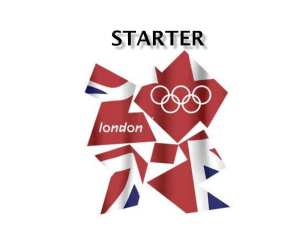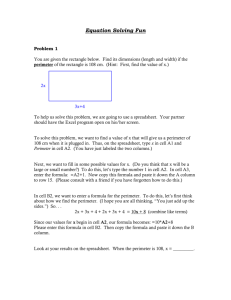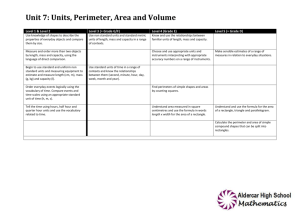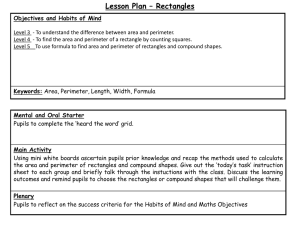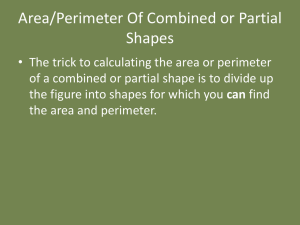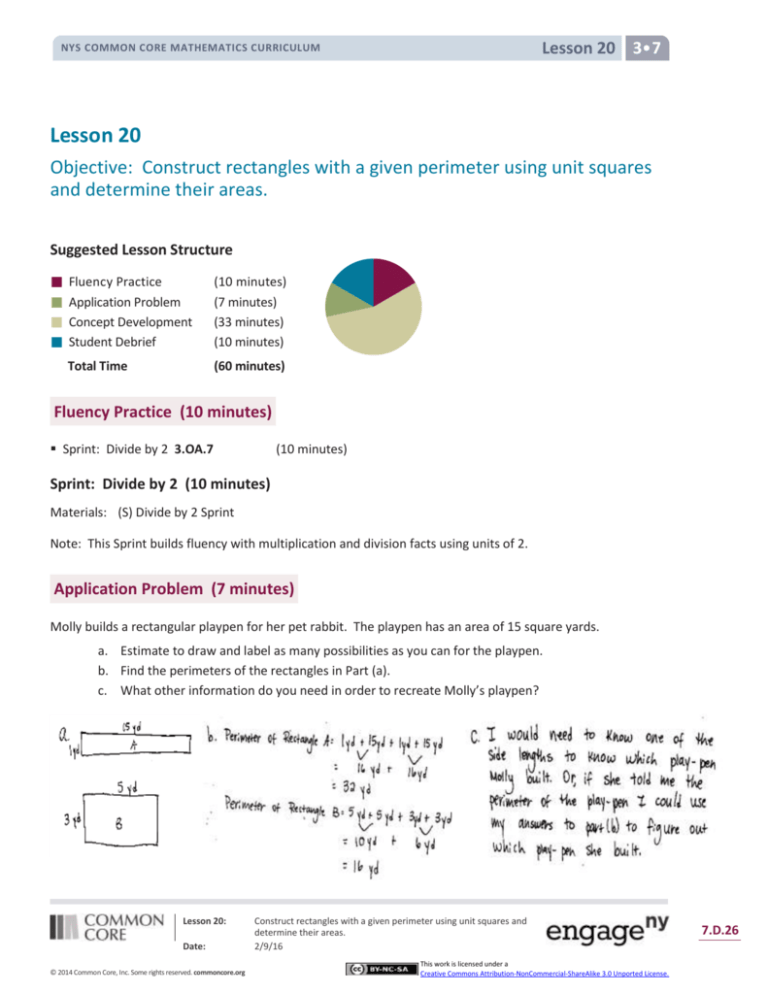
Lesson 20 3 7
NYS COMMON CORE MATHEMATICS CURRICULUM
Lesson 20
Objective: Construct rectangles with a given perimeter using unit squares
and determine their areas.
Suggested Lesson Structure
Fluency Practice
Application Problem
Concept Development
Student Debrief
Total Time
(10 minutes)
(7 minutes)
(33 minutes)
(10 minutes)
(60 minutes)
Fluency Practice (10 minutes)
Sprint: Divide by 2 3.OA.7
(10 minutes)
Sprint: Divide by 2 (10 minutes)
Materials: (S) Divide by 2 Sprint
Note: This Sprint builds fluency with multiplication and division facts using units of 2.
Application Problem (7 minutes)
Molly builds a rectangular playpen for her pet rabbit. The playpen has an area of 15 square yards.
a. Estimate to draw and label as many possibilities as you can for the playpen.
b. Find the perimeters of the rectangles in Part (a).
c. What other information do you need in order to recreate Molly’s playpen?
Lesson 20:
Date:
© 2014 Common Core, Inc. Some rights reserved. commoncore.org
Construct rectangles with a given perimeter using unit squares and
determine their areas.
2/9/16
This work is licensed under a
Creative Commons Attribution-NonCommercial-ShareAlike 3.0 Unported License.
7.D.26
Lesson 20 3 7
NYS COMMON CORE MATHEMATICS CURRICULUM
Note: This reviews the concepts learned in G3–M7–Lessons 18 and 19. You might invite students to discuss
whether or not one of the rectangles from Part (a) would be preferred as an outdoor playpen for a rabbit.
Concept Development (33 minutes)
Materials: (S) Problem Set, personal white board, unit square tiles
Note: This lesson includes two strategies for finding the length and width of a rectangle when the perimeter
is known. One strategy is written into the vignette, and the other is explained after the vignette. Before
delivering the lesson, read through both and decide which is most appropriate for the class. Depending on
the class, both may be taught.
T:
S:
T:
S:
T:
S:
T:
S:
T:
S:
T:
S:
T:
MP.5
S:
T:
Read the first sentence in Problem 1.
(Read: Use your unit square tiles to build as many rectangles as you can with a perimeter of 12
units.)
How is this problem different from the work we’ve been doing the past few days?
Before, we knew the area of the rectangle and had to
find length and width. Now, we need to use the
NOTES ON
perimeter to find the length and width.
MULTIPLE MEANS OF
When we knew area, we used pairs of factors to help
ACTION AND
us find length and width. What strategy might we use
EXPRESSION:
to help us when we know the perimeter?
Offer students the option of using a
We have to build or draw rectangles with different
12-cm or 12-inch piece of string or wire
lengths and widths and see if the perimeter is 12 units.
(rather than square tiles) to build
That could take a long time.
rectangles with a perimeter of 12 units
Let’s see what we can figure out. (Project the
in Problem 1 of the Problem Set.
labeled rectangle and equation shown to the
right.) Discuss with a partner how this equation
8 cm
represents the perimeter of the rectangle.
(Discuss.)
3 cm
Solve the addition fact and rewrite the equation
3 cm
using the sum.
(Write P = 2 × 11 cm.)
8 cm
When we multiply a number by 2, what are we
P = 2 × (3 cm + 8 cm)
doing to that number?
Doubling it!
So, this equation shows perimeter as double the sum of the width and length. Talk to a partner:
Can the perimeter of all rectangles be written as double the sum of the width and length?
Yes, because all rectangles have opposite sides that are equal.
Let’s see how knowing that helps with Problem 1. It asks us to use unit squares to build as many
rectangles as we can that have a perimeter of 12 units. We know that the perimeter, 12 units, is
double the sum of the width and length. What is the opposite of doubling a number?
Lesson 20:
Date:
© 2014 Common Core, Inc. Some rights reserved. commoncore.org
Construct rectangles with a given perimeter using unit squares and
determine their areas.
2/9/16
This work is licensed under a
Creative Commons Attribution-NonCommercial-ShareAlike 3.0 Unported License.
7.D.27
Lesson 20 3 7
NYS COMMON CORE MATHEMATICS CURRICULUM
S:
T:
S:
T:
MP.5
S:
T:
S:
T:
S:
T:
S:
T:
S:
Dividing a number by 2. Halving a number.
(Write the equation 12 ÷ 2 = 6.) What does the 6 in this equation represent in relation to a rectangle
with a perimeter of 12?
You divided the perimeter by 2, so 6 is the sum of the width and length. You halved the
perimeter and 6 is the sum of the width and length.
Now that we know the sum of the width and length,
we can find pairs of numbers that add to 6. Start at 1
Sample teacher’s board:
and work with a partner to write number sentences
that have a sum of 6. You only need to include a
12 ÷ 2 = 6
combination once.
1+5=6
(Write 1 + 5 = 6, 2 + 4 = 6, and 3 + 3 = 6.)
(Write number sentences.) Check your work with
2+4=6
mine, and make changes, if necessary. (Allow students
time to check their work.) What do these
3+3=6
combinations represent?
They’re the possible widths and lengths for a rectangle
with a perimeter of 12 units! Wait, how do we
know which is width and which is length?
NOTES ON
Sketch a rectangle one way, then trade the numbers
MULTIPLE MEANS OF
that go with width and length and sketch again. What
REPRESENTATION:
happens?
When using square tiles to build
Oh! It’s the same rectangle, just flipped. I guess it
rectangles of a certain perimeter,
doesn’t matter which is which for now.
clarify the unit being counted.
Use your unit squares to build each rectangle with the
Students count unit squares to find
widths and lengths that we found. Confirm that the
area, and count unit side lengths to
find perimeter.
perimeter is 12 units each time. Then, complete
Problem 1 on the Problem Set.
(Build rectangles, and then complete Problem 1.)
At the beginning of our lesson, we wondered which strategy we could use to find the width and
length of a rectangle when we know the perimeter. Retell this strategy to your partner.
(Discuss.)
Alternative (or Additional) Strategy:
If appropriate for your class, you might choose to teach the following strategy instead of or in addition to the
strategy demonstrated above. While this strategy has more steps than the strategy in the vignette, it does
not require students to know or figure out half of the perimeter. Finding half of the perimeter can become
tricky when students start to work with larger perimeters. As noted above, use discretion when deciding
which strategy is appropriate for the class.
Start with the same 3-cm by-8 cm rectangle as in the vignette.
Show the equation P = (2 × 3 cm) + (2 × 8 cm). Ask students how the equation represents the
perimeter of the rectangle.
Students see that the equation shows the perimeter as the sum of double the width and double the
Lesson 20:
Date:
© 2014 Common Core, Inc. Some rights reserved. commoncore.org
Construct rectangles with a given perimeter using unit squares and
determine their areas.
2/9/16
This work is licensed under a
Creative Commons Attribution-NonCommercial-ShareAlike 3.0 Unported License.
7.D.28
Lesson 20 3 7
NYS COMMON CORE MATHEMATICS CURRICULUM
length.
Knowing that, students can start at 1 and double numbers until they get to the given perimeter.
Then, they can find pairs of doubles that add up to the perimeter.
These pairs of doubles represent double the widths and lengths, so students will have to divide each
number by 2 to get the widths and lengths.
Example: Given a perimeter of 22 centimeters, students could find possible side lengths as shown below.
P = 22 cm
Doubles: 2, 4, 6, 8, 10, 12, 14, 16, 18, 20, 22
Pairs of doubles that add to 22: Half of these doubles:
2 + 20
w = 1, l = 10
4 + 18
w = 2, l = 9
6 + 16
w = 3, l = 8
8 + 14
w = 4, l = 7
10 + 12
w = 5, l = 6
Problem Set (10 minutes)
Students should do their personal best to complete the Problem Set within the allotted 10 minutes. For some
classes, it may be appropriate to modify the assignment by specifying which problems they work on first.
Some problems do not specify a method for solving. Students solve these problems using the RDW approach
used for Application Problems.
To prepare for G3–M7–Lesson 22,
students should add their data from
today’s lesson to the sheet shown at right.
(A master copy is included after the
Problem Set at the end of this lesson.)
Data will need to be collected on the same
sheet again at the end of G3–M7–Lesson
21. An extra five minutes is built into the
time allotted for the Concept
Development to accommodate this.
However, choose when the data collection
might happen most smoothly for your
class, perhaps at the end of the Problem
Set, Debrief, or after completing the Exit
Ticket.
Lesson 20:
Date:
© 2014 Common Core, Inc. Some rights reserved. commoncore.org
Construct rectangles with a given perimeter using unit squares and
determine their areas.
2/9/16
This work is licensed under a
Creative Commons Attribution-NonCommercial-ShareAlike 3.0 Unported License.
7.D.29
Lesson 20 3 7
NYS COMMON CORE MATHEMATICS CURRICULUM
Student Debrief (10 minutes)
Lesson Objective: Construct rectangles with a given
perimeter using unit squares and determine their areas.
The Student Debrief is intended to invite reflection and
active processing of the total lesson experience.
Invite students to review their solutions for the Problem
Set. They should check work by comparing answers with a
partner before going over answers as a class. Look for
misconceptions or misunderstandings that can be
addressed in the Debrief. Guide students in a
conversation to debrief the Problem Set and process the
lesson.
You may choose to use any combination of the questions
below to lead the discussion.
Share answers to Problems 1(c) and 1(d). Why
are the areas of the rectangles different, even
though the perimeters are the same?
What are the widths and lengths of the
rectangles you drew in Problem 2(a)? Explain to
a partner how you found the widths and lengths.
Share your answer to Problem 2(c) with a
partner. Why can’t you find the area of a
rectangle when you only know the rectangle’s
perimeter?
Look at the rectangles you drew in Problems 1(a)
and 2(a). Which perimeter allowed you to draw a
square? How do you know?
Exit Ticket (3 minutes)
After the Student Debrief, instruct students to complete
the Exit Ticket. A review of their work will help you assess
the students’ understanding of the concepts that were
presented in the lesson today and plan more effectively
for future lessons. You may read the questions aloud to
the students.
Lesson 20:
Date:
© 2014 Common Core, Inc. Some rights reserved. commoncore.org
Construct rectangles with a given perimeter using unit squares and
determine their areas.
2/9/16
This work is licensed under a
Creative Commons Attribution-NonCommercial-ShareAlike 3.0 Unported License.
7.D.30
NYS COMMON CORE MATHEMATICS CURRICULUM
Lesson 20:
Date:
© 2014 Common Core, Inc. Some rights reserved. commoncore.org
Lesson 20 Sprint 3 7
Construct rectangles with a given perimeter using unit squares and
determine their areas.
2/9/16
This work is licensed under a
Creative Commons Attribution-NonCommercial-ShareAlike 3.0 Unported License.
7.D.31
NYS COMMON CORE MATHEMATICS CURRICULUM
Lesson 20:
Date:
© 2014 Common Core, Inc. Some rights reserved. commoncore.org
Lesson 20 Sprint 3 7
Construct rectangles with a given perimeter using unit squares and
determine their areas.
2/9/16
This work is licensed under a
Creative Commons Attribution-NonCommercial-ShareAlike 3.0 Unported License.
7.D.32
NYS COMMON CORE MATHEMATICS CURRICULUM
Name
Lesson 20 Problem Set 3 7
Date
1. Use your square unit tiles to build as many rectangles as you can with a perimeter of 12 units.
a. Estimate to draw your rectangles below. Label the side lengths of each rectangle.
b. Explain your strategy for finding rectangles with a perimeter of 12 units.
c. Find the areas of all the rectangles in Part (a) above.
d. The perimeters of all the rectangles are the same. What do you notice about their areas?
Lesson 20:
Date:
© 2014 Common Core, Inc. Some rights reserved. commoncore.org
Construct rectangles with a given perimeter using unit squares and
determine their areas.
2/9/16
This work is licensed under a
Creative Commons Attribution-NonCommercial-ShareAlike 3.0 Unported License.
7.D.33
NYS COMMON CORE MATHEMATICS CURRICULUM
Lesson 20 Problem Set 3 7
2. Use your square unit tiles to build as many rectangles as you can with a perimeter of 14 units.
a. Estimate to draw your rectangles below. Label the side lengths of each rectangle.
b. Find the areas of all the rectangles in Part (a) above.
c. Given a rectangle’s perimeter, what other information do you need to know about the rectangle to
find its area?
Lesson 20:
Date:
© 2014 Common Core, Inc. Some rights reserved. commoncore.org
Construct rectangles with a given perimeter using unit squares and
determine their areas.
2/9/16
This work is licensed under a
Creative Commons Attribution-NonCommercial-ShareAlike 3.0 Unported License.
7.D.34
NYS COMMON CORE MATHEMATICS CURRICULUM
Name
Lesson 20 Exit Ticket 3 7
Date
1. Use your square unit tiles to build as many rectangles as you can with a perimeter of 8 units.
a. Estimate to draw your rectangles below. Label the side lengths of each rectangle.
b. Find the areas of the rectangles in Part (a) above.
Lesson 20:
Date:
© 2014 Common Core, Inc. Some rights reserved. commoncore.org
Construct rectangles with a given perimeter using unit squares and
determine their areas.
2/9/16
This work is licensed under a
Creative Commons Attribution-NonCommercial-ShareAlike 3.0 Unported License.
7.D.35
NYS COMMON CORE MATHEMATICS CURRICULUM
Lesson 20 Homework 3 7
-------------------------------------------------------------------------------------------------------------------------------------------Name
Date
1. Cut out the unit squares above. Then, use them to make as many rectangles as you can with a perimeter
of 10 centimeters.
a. Estimate to draw your rectangles below. Label the side lengths of each rectangle.
b. Find the areas of the rectangles in Part (a) above.
Lesson 20:
Date:
© 2014 Common Core, Inc. Some rights reserved. commoncore.org
Construct rectangles with a given perimeter using unit squares and
determine their areas.
2/9/16
This work is licensed under a
Creative Commons Attribution-NonCommercial-ShareAlike 3.0 Unported License.
7.D.36
NYS COMMON CORE MATHEMATICS CURRICULUM
Lesson 20 Homework 3 7
2. Gino uses unit square tiles to make rectangles with a perimeter of 14 units. He draws his rectangles as
shown below. Using square unit tiles, can Gino make another rectangle that has a perimeter of 14 units?
Explain your answer.
6 units
1 unit
4 units
3 units
3. Katie draws a square that has a perimeter of 20 centimeters.
a. Estimate to draw Katie’s square below. Label the length and width of the square.
b. Find the area of Katie’s square.
c. Estimate to draw a different rectangle that has the same perimeter as Katie’s square.
d. Which shape has a greater area, Katie’s square or your rectangle?
Lesson 20:
Date:
© 2014 Common Core, Inc. Some rights reserved. commoncore.org
Construct rectangles with a given perimeter using unit squares and
determine their areas.
2/9/16
This work is licensed under a
Creative Commons Attribution-NonCommercial-ShareAlike 3.0 Unported License.
7.D.37
Lesson 20 Data Sheet 3 7
NYS COMMON CORE MATHEMATICS CURRICULUM
Name
Date
Use the data you gathered from Problem Sets 20 and 21 to complete the charts to show how many rectangles
you can create with a given perimeter. You might not use all the spaces in the charts.
Perimeter = 10 units
Number of rectangles you made: _____
Perimeter = 12 units
Number of rectangles you made: _____
Width
Length
Area
Width
1 unit
4 units
4 square units
Length
Area
Perimeter = 14 units
Number of rectangles you made: _____
Perimeter = 16 units
Number of rectangles you made: _____
Width
Width
Length
Area
Length
Area
Perimeter = 18 units
Number of rectangles you made: _____
Perimeter = 20 units
Number of rectangles you made: _____
Width
Width
Length
Lesson 20:
Date:
© 2014 Common Core, Inc. Some rights reserved. commoncore.org
Area
Length
Area
Construct rectangles with a given perimeter using unit squares and
determine their areas.
2/9/16
This work is licensed under a
Creative Commons Attribution-NonCommercial-ShareAlike 3.0 Unported License.
7.D.38



